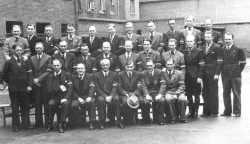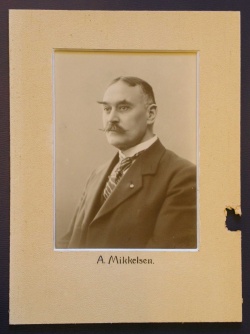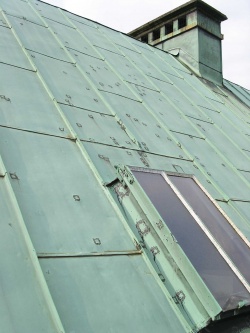State of War in Odense
01. Sep. 2005

The telephone division was photographed shortly after the liberation. Olrich Petersen is sitting in the fromt row to the left with a bandaged hand. Photo: G. Weisholt.
Establishment of the Telephone Division
As early as in October 1944 the resistance move-ment in Odense took measures to defend the Tele-phone House in case of German occupation of the house. Telephone fitter Holger Rasmussen, who was already involved in e.g. setting up illegal tele-phone lines for tapping of the Gestapo - the Ger-man Secret Police, was asked to form a defensive force of about 30 men.
Rasmussen quickly formed the requested division of telephone workers whom he knew he could trust. Being a former sergeant in the Danish army who had participated in the fighting in South Jutland at the occupation on 9th April 1940, he personal-ly managed the instruction in the use of arms. Moreover, he supplemented the division with two jour-neymen glovers from a neigbouring enterprise from where the gate to the Telephone House in Mun-kemoellestraede [street] could be monitored and with a porter at the central library right opposite the main entrance at 16, Klingenberg. The assignment of the extern members was to report if the Ger-mans were approaching the Telephone House.

The picture of A. Mikkelsen, a medlem of FKT's board of directors during the years 1912-33, was hanging in the boardroom when it was hit by a bullet on 5th May 1945. Unknown photographer.
In a State of Preparedness
In the evening of the 4th of May 1945 the radio an-nouncement of the German surrender was broad-cast from London and already at 10 p.m. the tele-phone division gathered, and they were all given weapons and ammunition as well as instructions about their tasks. The next morning at 5 a.m. everybody took up their positions. Some of the men were placed with about 25 metres' interval in the two streets outside the Telephone House.
The day of liberation passed relatively calmly for quite some time apart from some shooting from the KFUM [YMCA] building that housed the German air control centre of Funen as well as the military po-lice. There were many people in the street cele-brating liberty and trying to get a glimpse of resist-ance groups transporting German minions into captivity.
In Action
Late in the afternoon, around 5 p.m., the peace was over. As a result of increasing shooting at the town hall square of Odense, Flakhaven, and in Klingen-berg street, many people fled and some sought protection in the colonnade of the Telephone House.
The armed telephone workers tried in vain to calm down the crowd, but had to retire to the Telephone House. This made the crowd so desperate that it burst open the door to the Telephone House and took cover inside. When at the same time the German guard in the KFUM building was shut at, hand-grenades were thrown from there towards Klosterbakken which broke many window panes of the Telephone House. This caused the telephone operators to rush away from the switchboards so that it was suddenly no longer possible to telephone in the town of Odense.
From about 5.30 p.m. members of the resistance movement started to fire at the Telephone House from three different positions, probably in the belief that the Telephone House had been occupied by German soliders or Hipo's. "Hipo" was the designation of the German HilfsPolizei - a particularly coarse and brutal corps of Danish Nazi sympathizers that was justly feared by the population.
Via the Funen district exchange the telephone division succeeded twice in getting connection to re-sisters at the police station in the town hall, but these were unable to get in contact with the shooters.

During the shooting in Odense on 5th May 1945 the Telephone House was hit by about 850 bullets of which about 450 penetrated into the building and caused considerable damage. The picture shows the copper patching which was soldered on the bullet holes. Photo: Erik Juul.
The Fighting Culminates
A task force of members of the resistance move-ment then advanced towards the KFUM building under so heavy fire that eight of them lost their lives. Also the telephone division suffered a loss. Senior telephone fitter Hjendre Pedersen put his head out of a skylight to get an idea of the lie of the land, but was hit in the head by a bullet and died instantly. It was then decided to wave a white towel from a window in order to intimate that the Tele-phone House was not occupied. Porter Olrich Pe-tersen took upon himself to wave the "flag" and although he was shot in the hand, the signal worked. The shooting ended as suddenly as it had begun.
The people who had taken cover in the Telephone House were bundled out, the telephone division took up their positions again, and the exchange switchboards were manned anew even though the house was shot full of holes and hardly a single window was intact.
The episode was very sad as it was mainly resist-ers firing at resisters. The Germans in the KFUM building were, however, also involved and maybe the reason why the whole thing started. A memorial tablet for senior telephone fitter Hjendre Pedersen was later put up in the Telephone House.
This article may be copied or quoted with MuseumsPosten, Post & Tele Museum as source.
Comment this article
Only serious and factual comments will be published.